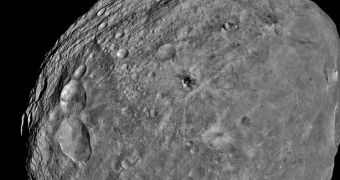After successfully entering orbit around Vesta – the largest space rock in the Inner Asteroid Belt – the NASA Dawn space probe is now getting ready to move into its first science orbits. During the year it will spend at the protoplanet, the spacecraft will take on a total of four such orbits.
The orbiter is the first ever to enter orbit around an IAB object. The achievement is all the more important considering that the study of Vesta may reveal new data on the origins and evolution of the solar system. At the same time, astronomers may also get a better understanding of planetary formation.
This particular asteroid is very important because it once had the potential to turn into a rocky planet, just like Mercury, Venus, Earth and Mars. However, a host of processes that unfolded in the early days of the solar system prevented that from happening, and experts want to learn what happened.
Dawn is currently being moved to an orbit 1,700 miles (2,700 kilometers) above Vesta. After maneuvering is complete, the spacecraft will be injected on the proper course on August 11, 2011.
“Now that we are in orbit around one of the last unexplored worlds in the inner solar system, we can see that it's a unique and fascinating place,” chief Dawn engineer Marc Rayman explains. He is also the mission manager, working out of the NASA Jet Propulsion Laboratory (JPL), in Pasadena, California.
“We have been calling Vesta the smallest terrestrial planet. The latest imagery provides much justification for our expectations,” adds Dawn's principal investigator, Chris Russell.
“They show that a variety of processes were once at work on the surface of Vesta and provide extensive evidence for Vesta's planetary aspirations,” says the scientist, who holds an appointment at the University of California in Los Angeles (UCLA).
In order to reach Vesta, Dawn spent more than 4 years flying towards the IAB. It covered a total of more than 1.7 billion miles (2.8 billion kilometers) in the processes. Vesta is located about 114 million miles (184 million kilometers) away from our planet at this point.
The spacecraft has a comprehensive suite of instruments it uses to conduct its studies. It includes gamma-ray and neutron detectors, visible and infrared spectrometers, as well as a number of cameras.
“The spectrometer is a modification of a similar one flying on the European Space Agency's Rosetta and Venus Express missions,” a NASA press release accompanying the announcement explains.
“The new observations of Vesta are an inspirational reminder of the wonders unveiled through ongoing exploration of our solar system,” NASA Headquarters Planetary Division director Jim Green explains.
Dawn will remain in orbit around the asteroid until July 2012, when it will depart for the dwarf planet Ceres. The orbiter will arrive at the latter in 2015, and start conducting scientific studies there as well.

 14 DAY TRIAL //
14 DAY TRIAL //